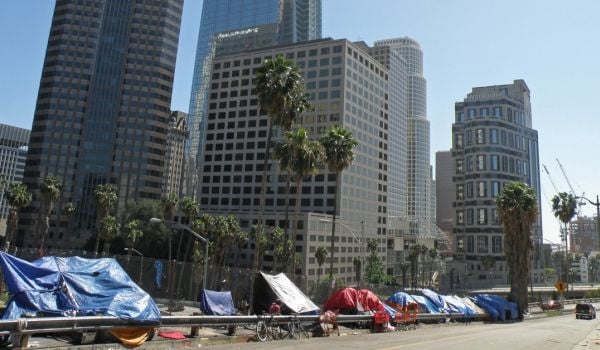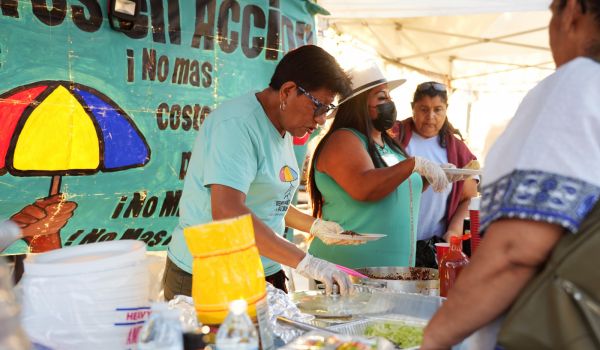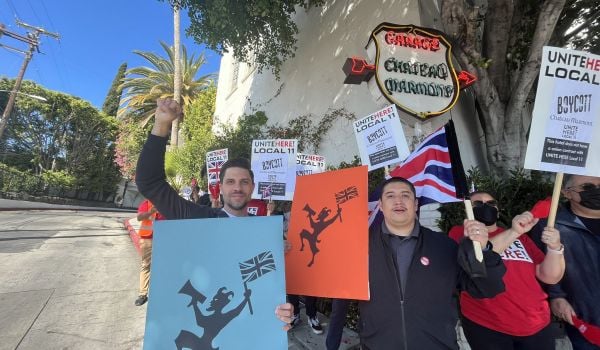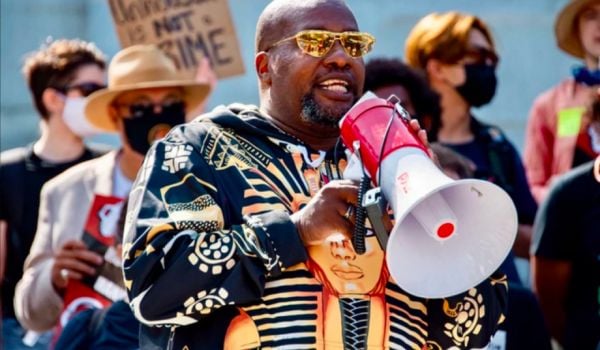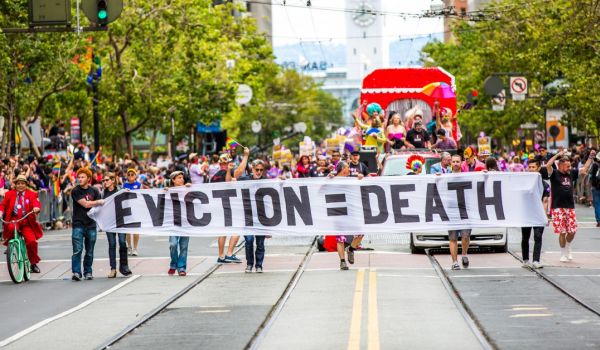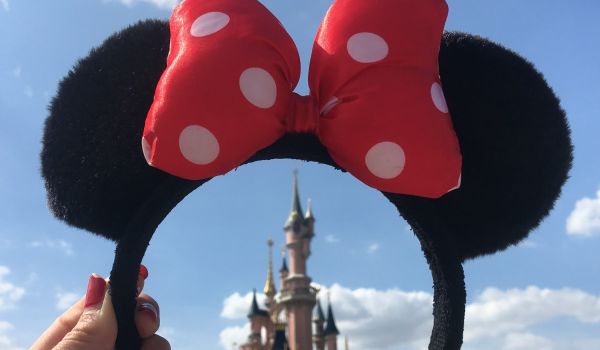As the suburbascape of metropolitan Los Angeles came into view, I couldn’t help but think of the 1980s song by the Missing Persons titled “Walking in L.A.” The song wasn’t triggered solely by the fact that I was traveling to L.A., where ghostly fingers of wildfire smoke drifted through the canyons on my flight’s descent. It was cued, also, because my sister played that song relentlessly in our central Florida home before she relocated, just a few years later, to the City of Angels to find her fortunes. I’m unsure of the cause-and-effect relationship with that move, but now whenever I visit my sister—who has lived in west Los Angeles for 25 years—it’s the requisite soundtrack with the quirky chorus: “Walkin’ in L.A., nobody walks in L.A.”
This was only a quick weekend visit—and I’ve otherwise not spent any extended period of time exploring L.A.—but from the handful of times I’ve been, I can’t help but think the song is only half right. It may be true that nobody walks in the wider suburbs of L.A., but there’s plenty of walking going on in some of the best and most authentic neighborhoods in America. That’s right: In my experience, Los Angeles has a great collection of pedestrian-oriented neighborhoods, old and new. So I guess the question then becomes: Is it healthy to walk among all that noxious air?
Or perhaps, like the song, that’s a stereotype, too. After all, I lived in Denver with its notorious brown cloud for nearly a decade, and found that outdoor urban living is one of that metropolitan area’s greatest attributes.
Regardless, on the Sunday following Independence Day, I had the chance to stroll among a classic site of successful suburban downtown redevelopment: Pasadena. And the person largely responsible for Old Town Pasadena’s turnaround is Rick Cole, the city’s mayor and a council member during the 1980s and early 1990s. By advocating for smart growth and traditional neighborhood design, Rick transitioned emphasis from automobile-oriented development to pedestrian-oriented community building. Now Pasadena is a premier, mixed-use city with a distinct sense of place. That’s helped of course by such venues as the Rose Bowl and the geography of the San Gabriel Valley, but Pasadena’s revived urban fabric is what truly distinguishes the city.
 After igniting Pasadena’s renaissance, Rick became city manager for the City of Azusa, where he served for six years. It was during that time—in 1998 at the Congress for New Urbanism in Denver—that I met him. We had already communicated via email, and Rick had volunteered to serve on Terrain.org’s initial editorial board (a role he still holds). So I knew of his passion for good urban design. What I didn’t learn until we met, though, is his commitment to the economic, social, environmental, and spiritual success of place—terms that when combined with design come to mean that a place is true, authentic. But then I didn’t fully know Rick’s credentials, either. He had already served as the Southern California director of the Local Government Commission, executive director of the West Hollywood Marketing Corporation, and cofounder of the Pasadena Weekly newspaper. Though his role was only advisory, his interest in getting Terrain.org up and running was keen.
After igniting Pasadena’s renaissance, Rick became city manager for the City of Azusa, where he served for six years. It was during that time—in 1998 at the Congress for New Urbanism in Denver—that I met him. We had already communicated via email, and Rick had volunteered to serve on Terrain.org’s initial editorial board (a role he still holds). So I knew of his passion for good urban design. What I didn’t learn until we met, though, is his commitment to the economic, social, environmental, and spiritual success of place—terms that when combined with design come to mean that a place is true, authentic. But then I didn’t fully know Rick’s credentials, either. He had already served as the Southern California director of the Local Government Commission, executive director of the West Hollywood Marketing Corporation, and cofounder of the Pasadena Weekly newspaper. Though his role was only advisory, his interest in getting Terrain.org up and running was keen.
His interest in making Southern California’s communities livable is keener still. Of his experience as mayor of Pasadena, he said in a keynote speech to the Mayors Institute on City Design in 1997, “An alternative is emerging…. It has many names: livable communities, new urbanism, neotraditional design, or transit-oriented development. People are asking: ‘Isn’t it about time to recapture our landscape and communities and our cities for something authentic? Something that is walkable, something that works, something that speaks to that hunger in us for real places where real people do real things. A good place to raise kids. Somewhere you might even stay to retire, where you could still attend the church where you raised your family.’” His work in Pasadena, Azusa, and now Ventura is about that alternative future.
Before becoming city manager of Ventura in 2004, Rick wrote a Terrain.org’s “People in Place” issue”>guest editorial for Terrain.org’s “People in Place” issue, affirming that authentic places are about people—that great neighborhoods serve the wide array of residents and visitors. But what is authentic, what is real, especially “in the meretricious geography of Southern California where old movie sets sometimes substitute for authentic history?” he asks. The answer: we don’t always know. What’s important, though, is to strive to go “beyond a perpetuation of memory and myth” and create “something anchored and tangible.”
More recently, The Los Angeles Times ran a profile of Rick, who in that same year of 2006 was named one of nine Public Officials of the Year by Governing Magazine, the only city manager in the nation to earn that distinction. In the profile, he is quoted as saying, “Design matters enormously in the making of great places. We have to design for what fits the land and its surroundings. That’s my passion.”
Lots has been written about what makes a “great place,” but many will agree that it starts with great neighborhoods. And new great neighborhoods require strong design—guidelines, architectural styles, public participation, and much more. On a larger scale, great neighborhoods and great cities also require a commitment from the city, as well as an understanding of what is valued.
“Downtown Ventura is on a roll,” Rick wrote in his Ventura City Manager Blog last year. “Other new housing developments are either underway or soon to break ground. New stores and restaurants are opening and some longtime businesses are getting a facelift…. Building on the success of the 1992 Downtown Specific Plan, the City Council recently adopted a new plan with the goal that ‘over the next ten years, Ventura will emphasize our history, culture and unique character to sustain our City’s authentic heart.’”
I haven’t had a chance to visit Azusa or Ventura. In fact, on this recent trip I had to leave Pasadena earlier than hoped to catch my flight back to Tucson. But I did have the opportunity to walk around my sister’s neighborhood in west Los Angeles. With her son and daughter, we ventured into a residential area of homes old and new. Though not a mixed-use neighborhood in the sense of services available within a five-minute walk, it is quite walkable, and her son’s school is only two blocks away. It also features a mix of three-story apartment buildings, duplexes, and single-family homes with off-street sidewalks and lush landscaping. In a word: authentic.
Near the end of our walk, that Missing Persons song popped into my head once again, and though the chorus is catchy, the lyrics themselves that are most telling:
Look ahead as we pass, try and focus on it
I won’t be fooled by a cheap cinematic trick
It must have been just a cardboard cut out of a man
Top-forty cast off from a record stand
…
Don’t know, could’ve been a lame jogger maybe
Or someone just about to do the freeway strangler baby
Shopping cart pusher or maybe someone groovie
One thing’s for sure, he isn’t starring in the movies.
…
You won’t see a cop walkin’ on the beat
You only see ‘em drivin’ cars out on the street
You won’t see a kid walkin’ home from school
Their mothers pick ‘em up in a car pool
…
Could it be that the smog’s playing tricks on my eyes
or is it a rollerskater in some kind of headphone disguise
Maybe somebody who just ran out of gas,
Making his way back to the pumps the best way he can.
Finally, the song concludes, “only a nobody walks in L.A.”
Thanks to the good work of leaders like Rick Cole, it’s not just nobodies who walk in L.A.—and the authentic neighborhoods of Los Angeles and Southern California are all the better for it.

